Historical background on the Black Sash
Establishment of the Black Sash: 1955-1956
- Founded in 1955 after six white women in Johannesburg met for tea on 19 May 1955. They were outraged at the government’s intentions regarding the Senate
Bill.
- Original issue: Opposition to the Senate Bill. The Senate Bill’s aim was to increase numbers of government supporters in the Senate to pass the Separate Representation of Voters Act that would remove “Coloureds” from the common voters’ roll thus violating an entrenched clause in the South African Constitution of
1910.
- At this stage they were called the Women's Defence of the Constitution League.
- Petitions, mass meetings, and vigils were methods of protest used. A cell system and a telephone network were used to communicate.
- The main aim was moral influence rather than political power.
- Wore black sashes in mourning for death of Constitution as they failed in their attempt to stop the government from passing the Senate Bill.
- The emblem of the Black Sash gave the group their name. The new name was officially inaugurated in April 1956 at the first National Conference in Bloemfontein.
- Initially membership was only open to female voters residing in South Africa (i.e. white women).
- At this time the Black Sash had 12 regions and more than 50 branches.
- It was the first time women had become involved in political affairs.
- Grounded in liberal tradition and establishment.
The early years of the Black Sash: 1956-early 1960s
- Started with issue of constitutionality but then developed into public education, protesting against injustices, racial discrimination and the erosion of the rule of law. i.e. legality and morality. This shift diminished the initial ranks.
- Used non-violent and peaceful means.
- 1958 Bail Fund established in Cape Town to assist people arrested for pass offences.
- Formed advice offices in urban centres where there were Black Sash regional structures to provide support and free paralegal services for concerns around housing, unemployment, pensions, influx control, detention without trial etc.
- The Athlone Advice Office was the first of such offices founded in the country. It was originally supported jointly by the Cape Western Region of the Black Sash and the South African Institute of Race Relations.
- The Advice Offices were staffed mainly by volunteers with people from the townships as interpreters.
- In 1963 membership broadened to all adult women residing in South Africa.
- Administration and conferences continued on a national level.
Persistence and protest: 1960s-1980s
- In the landscape of increasing repression and intimidation in 1960s and 1970s, numbers dwindled but advice offices were busy.
- Members did lots of research to keep informed about legislation, events and conditions in the country.
- Had firsthand experiences in advice office and through fieldworkers so members knew much about the country other whites were not aware of.
- Continued to protest publicly.
- Monitoring of legislation, courts, government policy and action.
- As resistance to Apartheid increased in late 1970s, monitoring of protests, rallies, marches and police reactions (banning, deaths in detention, detention without trial, disappearances).
- Used protection afforded by being white to speak out.
- 1985 Advice Office Trust established to raise and administer funds for the service work.
Transformation and evolution: 1990s-present
- Nelson Mandela called Black Sash the “conscience of white South Africa” on his release from prison in1990.
- In the early 1990s, the Black Sash worked on the new South African Constitution, conducted voter education, and continued with monitoring of legislation and Parliament:
- LegiWatch formed in 1990s with advocacy as a main aim.
- Mid-1990s, the Black Sash had to re-evaluate its role and started developing a new structure and focus. It moved from being member-driven, mainly volunteer and mainly white women to a non governmental organisation with a National Director and a Board of Trustees.
- In 1995, it became the Black Sash Trust.
- Current focus: Commitment to socio-economic rights, administrative justice (making rights a reality through access to justice), testing the Constitution, tackling poverty and HIV/Aids, commenting on policy and legislation, and continuing with the work of the advice offices
(Sources: Golden Jubilee report, The Black Sash of South Africa C. Michelman Oxford University Press, London 1995)
Administrative structure of the Black Sash
From its inception until 1995, the Black Sash had a national level and regional levels (made up of branches). The advice offices grew out of the regional structures and were administered by them until 1985 when the Black Sash Advice Office Trust was established to administer and raise funds for the advice offices. Before 1995 the national and regional levels were largely run by member volunteers. In 1995, the Black Sash Trust was established with paid staff, a National Director and a Board of Trustees. Some regional advice offices remain, as well as an advocacy unit and the national office. Theses structures fall under the Black Sash Trust. The Advice Office Trust has fallen away.
|
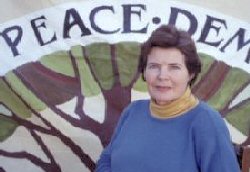
Mary Burton, Black Sash President 1986-1990
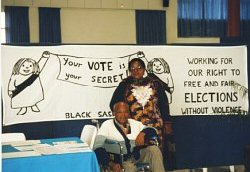
Norma Nabe and David Vithi of Cape Town AO at the PE conference
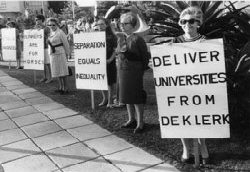
Black Sash Stand
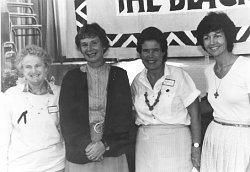
Margaret Nash, Rosemary Smith, Mary Burton, Di Bishop
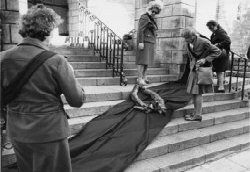
Laying Sash on St Georges Cathedral, Cape Town. From centre: Noel Robb, Barbara Brock and Mary Burton
|